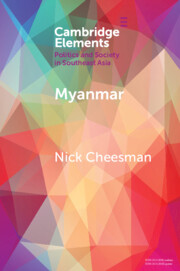119 results
7 - The International Labour Organization
-
- Book:
- International Organizations
- Published online:
- 17 May 2024
- Print publication:
- 06 June 2024, pp 159-180
-
- Chapter
- Export citation
Nuttalliellidae in Burmese amber: implications for tick evolution
-
- Journal:
- Parasitology , First View
- Published online by Cambridge University Press:
- 16 April 2024, pp. 1-17
-
- Article
-
- You have access
- Open access
- HTML
- Export citation
6 - The Red Cross Movement
-
- Book:
- The Contemporary International Committee of the Red Cross
- Published online:
- 01 February 2024
- Print publication:
- 01 February 2024, pp 114-132
-
- Chapter
- Export citation

Myanmar
- A Political Lexicon
-
- Published online:
- 11 January 2024
- Print publication:
- 01 February 2024
-
- Element
- Export citation
20 - Buddhism
- from Part II - Transnational and Religious Missions and Identities
-
-
- Book:
- The Cambridge History of Nationhood and Nationalism
- Published online:
- 08 November 2023
- Print publication:
- 09 November 2023, pp 437-458
-
- Chapter
- Export citation
Introduction
-
- Book:
- The Networked Leviathan
- Published online:
- 20 July 2023
- Print publication:
- 03 August 2023, pp 1-27
-
- Chapter
-
- You have access
- Open access
- HTML
- Export citation
3 - The Problem of Platform Knowledge
-
- Book:
- The Networked Leviathan
- Published online:
- 20 July 2023
- Print publication:
- 03 August 2023, pp 80-108
-
- Chapter
-
- You have access
- Open access
- HTML
- Export citation
Current status and needs in the primary healthcare system in Yangon, Myanmar: a mixed-method evaluation
-
- Journal:
- Primary Health Care Research & Development / Volume 24 / 2023
- Published online by Cambridge University Press:
- 18 May 2023, e37
-
- Article
-
- You have access
- Open access
- HTML
- Export citation
Strengthening small-scale fisheries management and conservation in Myanmar through locally managed marine areas
-
- Article
-
- You have access
- Open access
- HTML
- Export citation
Anthropogenic pressure on large carnivores and their prey in the highly threatened forests of Tanintharyi, southern Myanmar
-
- Article
-
- You have access
- Open access
- HTML
- Export citation
10 - Buddhist Constitutionalism beyond Constitutional Law
- from Part III - Southern Asia
-
-
- Book:
- Buddhism and Comparative Constitutional Law
- Published online:
- 18 November 2022
- Print publication:
- 01 December 2022, pp 198-219
-
- Chapter
-
- You have access
- Open access
- HTML
- Export citation
Disentangling vertebrate spatio-temporal responses to anthropogenic disturbances: evidence from a protected area in central Myanmar
-
- Article
-
- You have access
- Open access
- HTML
- Export citation
Hard ticks in Burmese amber with Australasian affinities
-
- Journal:
- Parasitology / Volume 150 / Issue 2 / February 2023
- Published online by Cambridge University Press:
- 07 November 2022, pp. 157-171
-
- Article
-
- You have access
- Open access
- HTML
- Export citation
4 - The Impact of Investment Treaties on the Rule of Law in Korea
-
-
- Book:
- Investment Treaties and the Rule of Law Promise
- Published online:
- 29 September 2022
- Print publication:
- 06 October 2022, pp 96-126
-
- Chapter
- Export citation
5 - Reflections on a Political Ecology of Sovereignty
- from Part II - Unmaking International Law
-
-
- Book:
- Locating Nature
- Published online:
- 22 September 2022
- Print publication:
- 29 September 2022, pp 134-158
-
- Chapter
- Export citation
Sovereignty as Care: Acquaintances, Mutuality, and Scale in the Wa State of Myanmar
-
- Journal:
- Comparative Studies in Society and History / Volume 64 / Issue 4 / October 2022
- Published online by Cambridge University Press:
- 02 September 2022, pp. 910-933
-
- Article
-
- You have access
- Open access
- HTML
- Export citation
Can regime change improve ethnic relations? Perception of ethnic minorities after the 2021 coup in Myanmar
-
- Journal:
- Japanese Journal of Political Science / Volume 23 / Issue 2 / June 2022
- Published online by Cambridge University Press:
- 16 May 2022, pp. 89-104
-
- Article
-
- You have access
- Open access
- HTML
- Export citation
4 - Follow the Money
-
- Book:
- Banking on Beijing
- Published online:
- 21 April 2022
- Print publication:
- 05 May 2022, pp 97-121
-
- Chapter
- Export citation
Accumulations and Cascades: Burmese Elephants and the Ecological Impact of British Imperialism
-
- Journal:
- Transactions of the Royal Historical Society / Volume 32 / December 2022
- Published online by Cambridge University Press:
- 13 April 2022, pp. 177-197
- Print publication:
- December 2022
-
- Article
-
- You have access
- Open access
- HTML
- Export citation
High morphological disparity of neuropteran larvae during the Cretaceous revealed by a new large species
-
- Journal:
- Geological Magazine / Volume 159 / Issue 6 / June 2022
- Published online by Cambridge University Press:
- 04 April 2022, pp. 954-962
-
- Article
-
- You have access
- HTML
- Export citation



